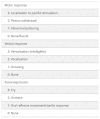Nociception Coma Scale-Revised with Personalized Painful Stimulus Versus Standard Stimulation in Persons with Disorders of Consciousness: An International Multicenter Study
- PMID: 39337015
- PMCID: PMC11432094
- DOI: 10.3390/jcm13185528
Nociception Coma Scale-Revised with Personalized Painful Stimulus Versus Standard Stimulation in Persons with Disorders of Consciousness: An International Multicenter Study
Abstract
Background/Objectives: Persons with disorders of consciousness (DoCs) may perceive pain without being able to communicate their discomfort. The Nociception Coma Scale (NCS) and its revised form (NCS-R) have been proposed to assess nociception in persons with DoCs. The main aim of this international multicenter study was to confirm (or not) our preliminary results and compare the NCS-R scores of standard stimulus (NCS-R-SS) to scores of personalized painful stimuli (NCS-R-PS). A secondary aim of the study was to verify possible correlations between the NCS-R-PS and Coma Recovery Scale-Revised (CRS-R) and to estimate convergent validity. Methods: Sixty-one patients with prolonged DoCs (pDoCs) were enrolled from seven European post-acute rehabilitation centers. Responsiveness and pain perception were assessed by CRS-R and NCS-R with standard stimulus (NCS-R-SS) and personalized stimulation (NCS-R-PS). ClinicalTrials.gov Identifier: NCT06012357. Results: our results support our prior findings on the superiority and the validity of the personalized painful stimulus approach in assessment of pain in persons with DoCs in comparison with the standardized pain assessment methodology. Conclusions: A more in-depth and tailored assessment of pain perception in persons with a DoC may lead to better acknowledgment of its presence and by extension an objective foundation for more aggressive and appropriate pain management.
Keywords: coma recovery scale—revised; disorders of consciousness; nociception coma scale.
Conflict of interest statement
The authors declare no conflicts of interest.
Figures

References
-
- Armstrong M.J., Giacino J.T., Katz D.I., Schiff N.D., Whyte J., Ashman E.J., Ashwal S., Barbano R., Hammond F.M., Laureys S., et al. Author response: Practice guideline update recommendations summary: Disorders of consciousness: Report of the Guideline Development, Dissemination, and Implementation Subcommittee of the American Academy of Neurology; the American Congress of Rehabilitation Medicine; and the National Institute on Disability, Independent Living, and Rehabilitation Research. Neurology. 2018;91:1164. doi: 10.1212/wnl.0000000000007669. - DOI - PubMed
-
- Giacino J.T., Ashwal S., Childs N., Cranford R., Jennett B., Katz D.I., Kelly J.P., Rosenberg J.H., Whyte J.O.H.N., Zafonte R.D., et al. The minimally conscious state: Definition and diagnostic criteria. Neurology. 2002;58:349–353. - PubMed
-
- Laureys S., Celesia G.G., Cohadon F., Lavrijsen J., León-Carrión J., Sannita W.G., Sazbon L., Schmutzhard E., Von Wild K.R., Zeman A., et al. Unresponsive wakefulness syndrome: A new name for the vegetative state or apallic syndrome. BMC Med. 2010;8:68. doi: 10.1186/1741-7015-8-68. - DOI - PMC - PubMed
-
- Thibaut A., Chatelle C., Wannez S., Deltombe T., Stender J., Schnakers C. Spasticity in disorders of consciousness: A be-havioral study. Eur. J. Phys. Med. Rehab. 2015;51:389–397. - PubMed
Associated data
LinkOut - more resources
Full Text Sources
Medical

